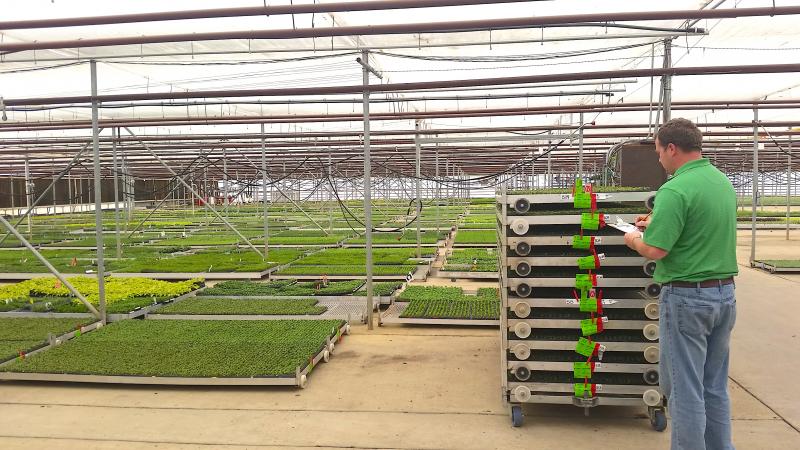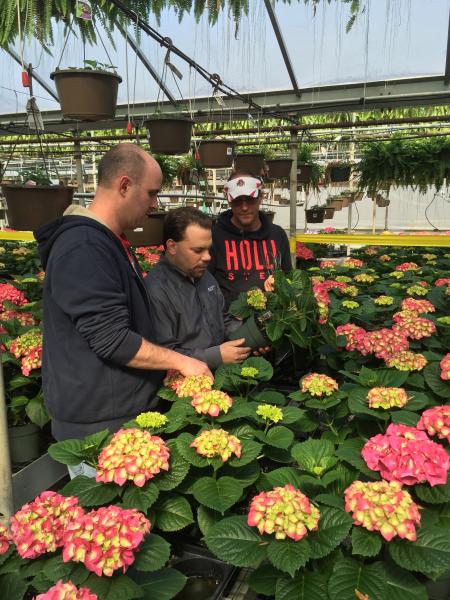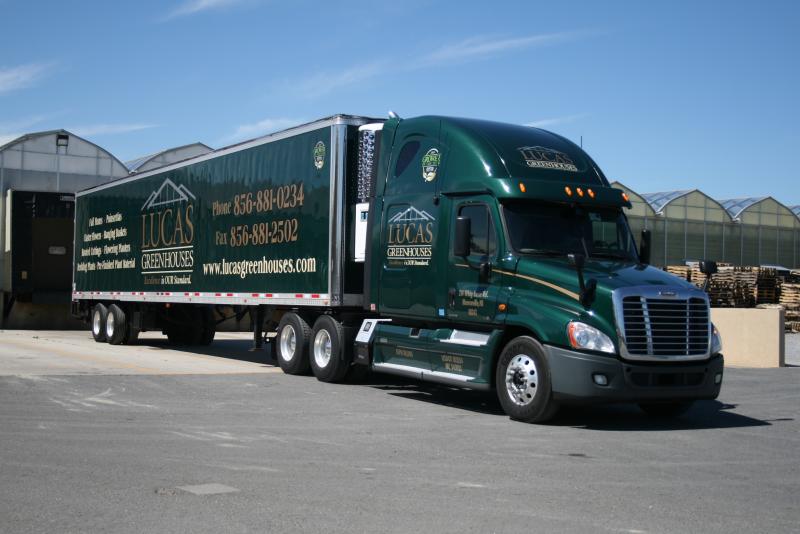On-Time Delivery That Thinks Outside the Docks
 Pinpoint accurate forecasting helps Bela Flor Nurseries meet demand without spoilage or delays.
Pinpoint accurate forecasting helps Bela Flor Nurseries meet demand without spoilage or delays.
When it comes to customer satisfaction, few criteria rank as high as receiving things on time. Whether you’re talking about your hourly news fix, your Friday night pizza, or a product that’s integral to the day-to-day functioning of your business, the timing of delivery is paramount.
It’s no different in the horticultural business. In fact, most industry experts would argue that on-time delivery is the life blood of their business.
Steve Beall, vice president of sales and marketing at Landmark Plastic wholeheartedly agrees, citing a recent company study where on-time delivery was considered the No. 1 contributor to customer satisfaction. Bill Grady from N.G. Heimos Greenhouses in southern Illinois, concurs.
“Given our exclusive focus on perishable products, being on time is everything to us.” Landmark and Heimos are not alone in this thinking, given that organizations go to great lengths to evaluate and improve their own delivery performance.
Focus on the Right Things
Unfortunately, when it comes to assessing on-time delivery, many organizations only focus on a snapshot in time when their loaded trucks leave the dock and arrive at their customers’ location. But as today’s supply chains grow more and more sophisticated, it is important for companies to look at things outside of the docks before shipments are merely released and then signed-in hours, days or weeks later at the other end of the chain.
Possibly the most overlooked influencer of on-time delivery is a company’s understanding of the marketplace. For example, in the horticultural market, one needs to know much more than just the manufacturing completion date.
You need to know about raw material influences, manufacturing lead times, consumer trends, Big Box influences, geographic growing seasons, weather conditions and grower lead times, just to name a few. To grasp all of this and more, the most sucessful companies rely on a sales force that possesses the kind of market knowledge that could fill a room of encyclopedias; a team that doesn’t just know their own business, but seeks to understand other industries that rub elbows with their own.
“My base knowledge stems from my history in the business and my natural curiosity,” states Landmark Plastic’s Joe Donley, a 25-year veteran of the horticulture industry.
“I’m always asking my customers questions about their operation, how our containers might satisfy their needs, and what can we do to address their pain points. I’m also active at many of the industry events, looking to gather as much information as possible. After all, the more I know, the more I can help. And it’s that knowledge that helps me deliver exactly what my customers need when they need it.”
 At Landmark Plastic, on-time delivery starts by spending time getting to know growers inside and out.
At Landmark Plastic, on-time delivery starts by spending time getting to know growers inside and out.
Knowledge is Power
A wealth of industry knowledge empowers companies to suggest new applications and identify emerging markets that can push them forward with new product development, new alliances and even new marketing strategies. This insight also helps organizations recognize obstacles and bottlenecks that may lie ahead, all of which enables them to allocate human resources, equipment, raw material and financial assets more effectively to improve delivery performance.
But raw knowledge is really just the beginning. When it comes to improving on-time delivery, it’s what sales ninjas like Donley do with that insight weeks, even months, prior to taking customer orders that can truly make a difference. In a word, forecasting. This self-assessment tool uses current and historic sales data to predict future performance. And when you apply just-in-time (JIT) principles to the mix, accurate sales forecasts become even more difficult to achieve while at the same time more critical.
“We grow most of our plants from seed and cuttings,” explains Joe Harris at Bela Flor Nurseries in Missouri. “We can’t afford to have our plugs expire, which is why accurate forecasting is so crucial. In fact, we’re always looking for ways to narrow our production window, so it’s natural for us to seek business partners who share that same philosophy who work closely with us, communicating throughout every phase of their process, so everything tracks as we’ve planned.”
Grady from N.G. Heimos agrees, stating, “Accurate forecasting is key, and it comes from on-going, honest communication with our vendors. The “No BS” rule really applies here because we’re looking to make business decisions on the information our vendors provide. And if we can trust their input, then everyone’s golden.”
Since no company wants to stockpile inventory, manufacturers are challenged to align market demand with production lead-times. Accurate forecasting allows companies to better plan for those future demands ramping up manufacturing ahead of seasonal rushes, for example, and adjusting resources during off cycles. In short, the ability to accurately forecast sales can mean the difference between product that is delivered late to a very unhappy grower and product that is delivered on time to a grower that immediately adds you to his Christmas card list. In more concrete terms, the overall impact of accurate sales forecasting is a business that operates more efficiently and serves its customers more effectively.
 On-time delivery is so critical for Lucas Greenhouses that they often send their own trucks to retrieve orders from vendors.
On-time delivery is so critical for Lucas Greenhouses that they often send their own trucks to retrieve orders from vendors.
The Right Network
Beyond market knowledge that supports an organization’s ability to accurately forecast sales and production, another important aspect of on-time delivery that businesses should assess is their distribution network. You could utilize the most accurate sales forecasting tools on Earth, but if you’re not paying close attention to distribution, on-time delivery will be just a pipe dream, especially in today’s ultra-competitive marketplace. This is why many companies are looking for fresh approaches to standard distribution models in order to get their products from point A to point B more quickly.
One company who knows all about that is Plant Marketing in central Florida. Plant Marketing sees distribution as yet another opportunity to apply unconventional wisdom.
“In talking with some of our suppliers,” says Denise Dickens, Plant Marketing’s general manager, “we realized that by leasing a portion of our available warehouse space to preferred business partners, we could get the product we need from them literally on-demand while also providing them with an alternative distribution point that required little to no investment. In this scenario, everyone wins.”
Plant Marketing has been offering this alternative approach for the past four years.
In addition to renting a portion of the Plant Marketing warehouse to secure a southern U.S. distribution point, those vendors also have joined forces to piggyback their own shipments out of the satellite warehouse. So products from different companies, all going to the same destination, are consolidated into one truck for speedier and more cost-effective distribution.
 N.G. Heimos looks to open and honest communication as the solution to the challenges of on-time delivery.
N.G. Heimos looks to open and honest communication as the solution to the challenges of on-time delivery.
Taking Control
While everyone can agree that delivery performance is important, there are some that feel it is so critical to their operation that they have taken matters into their own hands.
“Timing is so vital that we often drive our own trucks to pick up product from our vendors,” says George Lucas of New Jersey-based Lucas Greenhouses. “Not only does this help keep my trailers moving, but it gives us greater flexibility, and since we know our own schedule best allows us to control more of the process.”
So, what does all of this mean to on-time delivery? It means that when you investigate multiple aspects of delivery performance not just the final destination and you make intelligent decisions based on those findings, the chances of improving can increase dramatically.
By thinking outside the docks, growers and their suppliers can achieve on-time delivery rates that please everyone.


 Video Library
Video Library 




















